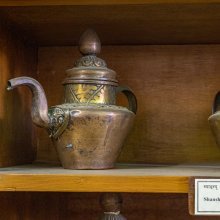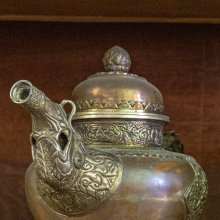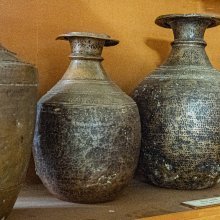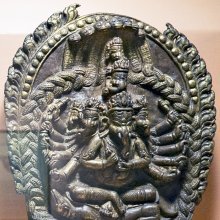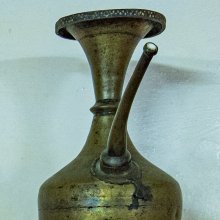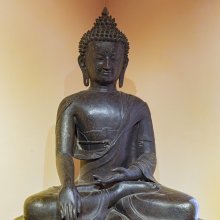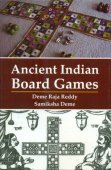Copper: 4 definitions
Introduction:
Copper means something in Hinduism, Sanskrit, biology. If you want to know the exact meaning, history, etymology or English translation of this term then check out the descriptions on this page. Add your comment or reference to a book if you want to contribute to this summary article.
Images (photo gallery)
(+104 more images available)
In Hinduism
Natyashastra (theatrics and dramaturgy)
Source: Shodhganga: Elements of Art and Architecture in the Trtiyakhanda of the Visnudharmottarapurana (natya)Copper is associated with Catura-hasta: one of the twenty-two Single-hand Gestures (in Indian Dramas) (known as asaṃyuktahastas), according to the Viṣṇudharmottarapurāṇa, an ancient Sanskrit text which (being encyclopedic in nature) deals with a variety of cultural topics such as arts, architecture, music, grammar and astronomy.—According to the Viṣṇudharmottarapurāṇa, some colours are pointed with the catura hand gesture. [...] Instead of showing colours, in the Abhinayadarpaṇa, the caturahasta posture denotes some metals like gold, copper and iron. This posture also shows the application of some greasy substances like oil, ghee etc on the face

Natyashastra (नाट्यशास्त्र, nāṭyaśāstra) refers to both the ancient Indian tradition (shastra) of performing arts, (natya—theatrics, drama, dance, music), as well as the name of a Sanskrit work dealing with these subjects. It also teaches the rules for composing Dramatic plays (nataka), construction and performance of Theater, and Poetic works (kavya).
Shilpashastra (iconography)
Source: Shodhganga: Elements of Art and Architecture in the Trtiyakhanda of the Visnudharmottarapurana (shilpa)Copper is denoted by the Sanskrit term Tāmra and represents one of the materials used to make Colours in the ancient Indian tradition of Painting (citra), according to the Viṣṇudharmottarapurāṇa, an ancient Sanskrit text which (being encyclopedic in nature) deals with a variety of cultural topics such as arts, architecture, music, grammar and astronomy. In the Viṣṇudharmottarapurāṇa, various materials are seen to be used to make colours. e.g., Copper (tāmra). Also, five colours are regarded as the primary ones, (viz., white, yellow, colour of vilomata, black, dark blue.). A painter can create hundreds or thousands of colours by amalgamating the primary colours.

Shilpashastra (शिल्पशास्त्र, śilpaśāstra) represents the ancient Indian science (shastra) of creative arts (shilpa) such as sculpture, iconography and painting. Closely related to Vastushastra (architecture), they often share the same literature.
Yoga (school of philosophy)
Source: ORA: Amanaska (king of all yogas): A Critical Edition and Annotated Translation by Jason BirchCopper is denoted by the Sanskrit term Tāmra, according to the Amanaska Yoga treatise dealing with meditation, absorption, yogic powers and liberation.—Accordingly, as Īśvara says to Vāmadeva: “[...] When the highest reality is revealed by the guru, [the Yogin] becomes instantly absorbed in it. Having liberated the self by the self, he is certainly liberated. Just as copper (tāmra) becomes gold from the touch of fixed mercury, [so] the student becomes absorbed in the highest reality from hearing the teachings of the Guru. [...]”.

Yoga is originally considered a branch of Hindu philosophy (astika), but both ancient and modern Yoga combine the physical, mental and spiritual. Yoga teaches various physical techniques also known as āsanas (postures), used for various purposes (eg., meditation, contemplation, relaxation).
Biology (plants and animals)
Source: Google Books: CRC World Dictionary (Regional names)Copper in English is the name of a plant defined with Cordia alliodora in various botanical sources. This page contains potential references in Ayurveda, modern medicine, and other folk traditions or local practices It has the synonym Lithocardium alliodorum (Ruiz & Pavon) Kuntze (among others).
Example references for further research on medicinal uses or toxicity (see latin names for full list):
· Allgemeine Naturgeschichte
· Revisio Generum Plantarum (1891)
· Acta Botanica Hungarica (1988)
· Turrialba (1972)
· Flora Peruviana (1799)
· Systema Naturae (1759)
If you are looking for specific details regarding Copper, for example health benefits, side effects, diet and recipes, extract dosage, pregnancy safety, chemical composition, have a look at these references.

This sections includes definitions from the five kingdoms of living things: Animals, Plants, Fungi, Protists and Monera. It will include both the official binomial nomenclature (scientific names usually in Latin) as well as regional spellings and variants.
See also (Relevant definitions)
Starts with: Copper globemallow, Copper leaf ammannia, Copper-stem corkwood, Copperleaf, Copperpod.
Full-text (+1588): Tamra, Tamrapatra, Pancaloha, Loha, Tamrika, Kamsya, Raviloha, Dvyashta, Tamrapatta, Dvishta, Shulva, Tuttha, Shaulvika, Ravipriya, Lauha, Trilohaka, Kaniyasa, Suryahva, Ashtadhatu, Tamraka.
Relevant text
Search found 204 books and stories containing Copper; (plurals include: Coppers). You can also click to the full overview containing English textual excerpts. Below are direct links for the most relevant articles:
The Gospel of Buddha (by Paul Carus)
Satirical works of Kshemendra (study) (by Arpana Devi)
5.11. The Tradesman (vaṇik) < [Chapter 5 - Kṣemendra’s objectives of Satire]
7.5. Summary of the Kuṭṭanīmatam < [Chapter 1 - Introduction]
3. Rasa or the sentiment < [Chapter 4 - Literary study of the Three Satirical Works]
Rasa Jala Nidhi, vol 3: Metals, Gems and other substances (by Bhudeb Mookerjee)
Part 3 - Incineration of copper < [Chapter III - Metals (3): Tamra (copper)]
Part 1 - Characteristics of Copper (tamra) < [Chapter III - Metals (3): Tamra (copper)]
Part 2 - Purification of copper < [Chapter III - Metals (3): Tamra (copper)]
Settlement in Early Historic Ganga Plain (by Chirantani Das)
Part 4 - Metal crafts of the Vārāṇasī region < [Chapter VI - Vārāṇasī: Emergence of the Urban Centre and Seat of Administration]
Part 5 - Minerals located near the Vārāṇasī region < [Chapter V - Rise of Vārāṇasī as a Nodal Centre]
Part 5 - Glass industry of the Vārāṇasī region < [Chapter VI - Vārāṇasī: Emergence of the Urban Centre and Seat of Administration]
The Devi Bhagavata Purana (by Swami Vijñanananda)
Chapter 37 - On the eighty-six Kuṇḍas and their characteristics < [Book 9]
Chapter 33 - On the description of the destinies of different sinners in different hells < [Book 9]
Chapter 10 - On the description of Maṇi Dvīpa < [Book 12]
Rasa Jala Nidhi, vol 1: Initiation, Mercury and Laboratory (by Bhudeb Mookerjee)
Part 1 - Additional process for transformation of base metals into gold and silver < [Chapter VIII - Conclusion of first volume]
Part 7 - Mercurial operations (5): Sublimation of Mercury (patana) < [Chapter IV-V - Mercurial operations]
Part 20 - Mercurial operations (18): Transformation of base metals into gold by mercury (bedhana) < [Chapter IV-V - Mercurial operations]
Related products
(+3 more products available)
